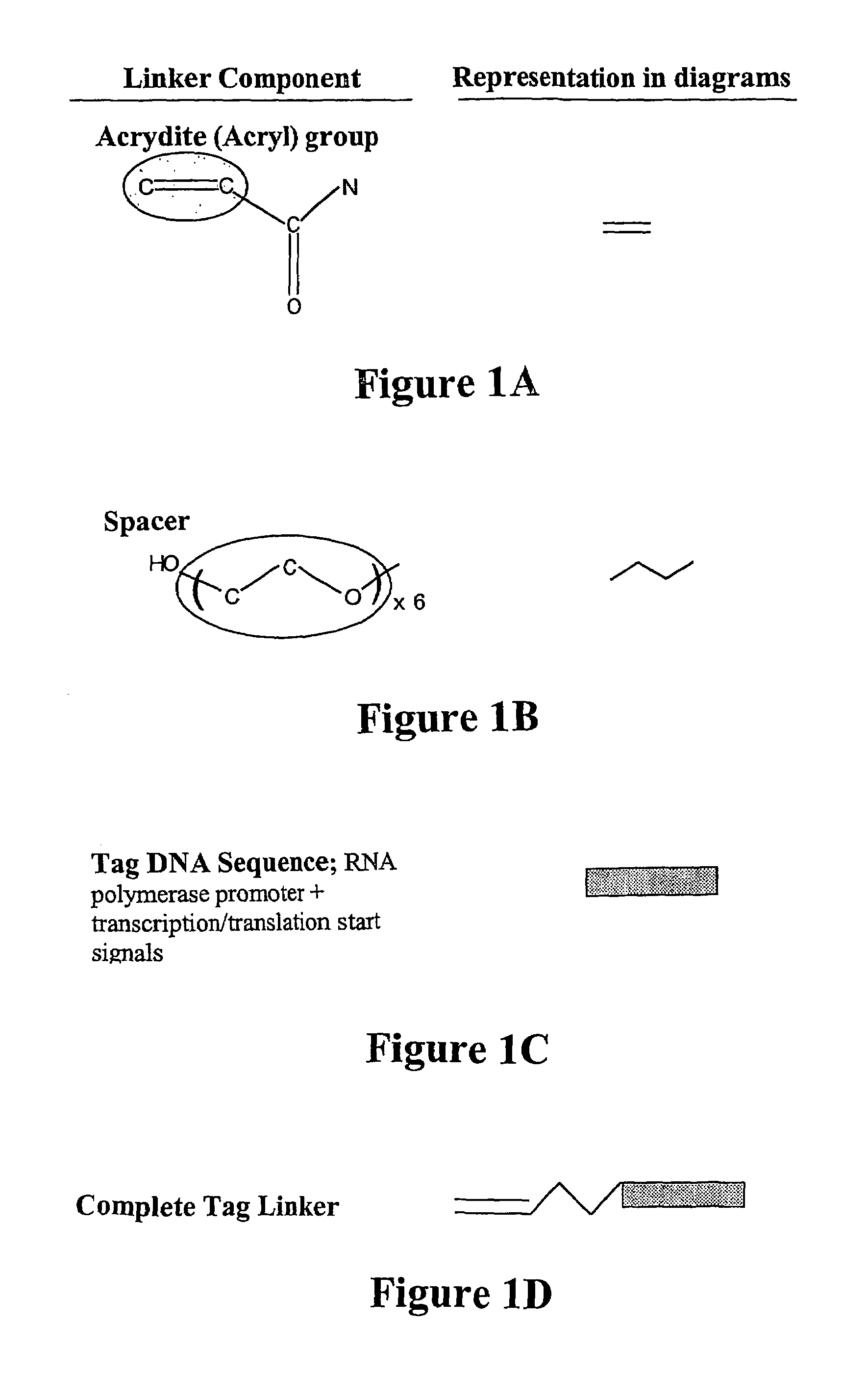Nucleic acid anchoring system comprising covalent linkage of an oligonucleotide to a solid support
a nucleic acid and solid support technology, applied in the field of nucleic acid anchoring system, can solve the problems of limiting the accuracy of any immobilization reaction, unable to enable the full gamut of nucleic acid manipulation now available to be performed on single and mixtures of nucleic acid molecules, etc., to achieve the effect of facilitating immobilization or anchoring
- Summary
- Abstract
- Description
- Claims
- Application Information
AI Technical Summary
Benefits of technology
Problems solved by technology
Method used
Image
Examples
example 1
Selection of Components of Anchoring Systems
1. Solid support
The physicochemical structure of the surface of the solid support is an important consideration for the choice of chemical reactive moiety of the DNA to exploit for covalent attachment. The main attributes of the surface are:
[0114](a) ease of manipulation;[0115](b) inexpensive;[0116](c) stable in extremes of temperatures; and[0117](d) stable in both aqueous and organic solvents.
[0118]Suitable surfaces include glass slides for solid microarrays and silica and methacrylate microspheres for use in suspension arrays, optical fiber arrays, or micromachined devices. The one favoured at the moment and representing the most common conjugation chemistry involves a thiolated surface is exemplified below.
2. A Universal Tag for Initial Modification of the Surface
[0119]In the present system, a reactive end (amine, thiol or acryl group) is used at the 5′ end of the DNA oligonucleotide. In the example given here, the 5′ reactive group is ...
example 2
System Set-Up
1. Tag is Conjugated to Surface
[0130]The execution of this step depends on the chemistry and surface used. The assay for measurement of amount of covalent binding is performed by binding α-tag to the solid surface. Amount of fluorescence at 521 nm is measured after excitation by a high-energy light source. The argon ion laser of the ABI 377, ABI 3700 or BD FacsCalibur may conveniently be used to measure this quantity.
2. Target is Ligated to Tag by Bridging Ligation
[0131]The bridge and target are added in equimolar amounts to the tag-modified surface with T4 DNA ligase. Successful ligation of target to tag is measured indirectly by measuring the ligation of α-tag to bridge electrophoretically (a 27-mer vs an 11-mer and a 16-mer) or by measuring the binding of OLIGREEN, a single stranded fluorescent binding dye from Molecular Probes. By measuring the amount of binding to the surface before and after ligation, it is easy to quantify the amount of ssDNA gained by the ligati...
example 3
Universal Primed Target Production
[0132]The primary aim of this Example is to introduce a high efficiency, low cost, easily used microsphere based system for capturing nucleic acid molecules. The present system is useful for specific testing of reagents which can be used in conjunction with a flow cytometer or other bead based instrument.
[0133]The system may also be used for generation of capture reagents for combinatorial screening as well as a system for solid phase PCR and / or single-stranded extensions.
[0134]The three component linker used to modify a thiolated solid phase is shown in FIG. 1.
[0135]A Universal Forward Oligo (UF) is then generated and in one example comprises the SP6 RNA polymerase promoter with a 5′ acrydite, a 30-atom spacer, followed by the sequence. This is conjugated to form a bead: UF complex (FIG. 2).
[0136]The efficiency of conjugation is measured by measuring the binding of α-UFO which is a phosphorylated, internally labeled complement to the first 13 bases...
PUM
| Property | Measurement | Unit |
|---|---|---|
| size | aaaaa | aaaaa |
| thermal stability | aaaaa | aaaaa |
| stability | aaaaa | aaaaa |
Abstract
Description
Claims
Application Information
 Login to View More
Login to View More - R&D
- Intellectual Property
- Life Sciences
- Materials
- Tech Scout
- Unparalleled Data Quality
- Higher Quality Content
- 60% Fewer Hallucinations
Browse by: Latest US Patents, China's latest patents, Technical Efficacy Thesaurus, Application Domain, Technology Topic, Popular Technical Reports.
© 2025 PatSnap. All rights reserved.Legal|Privacy policy|Modern Slavery Act Transparency Statement|Sitemap|About US| Contact US: help@patsnap.com



